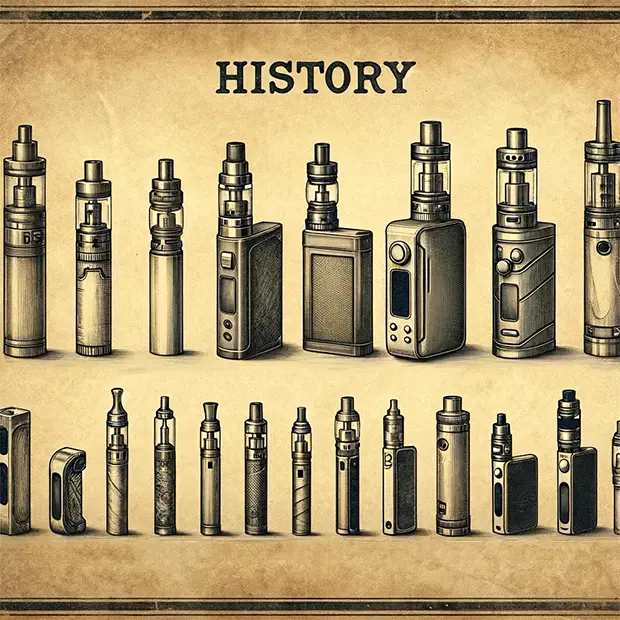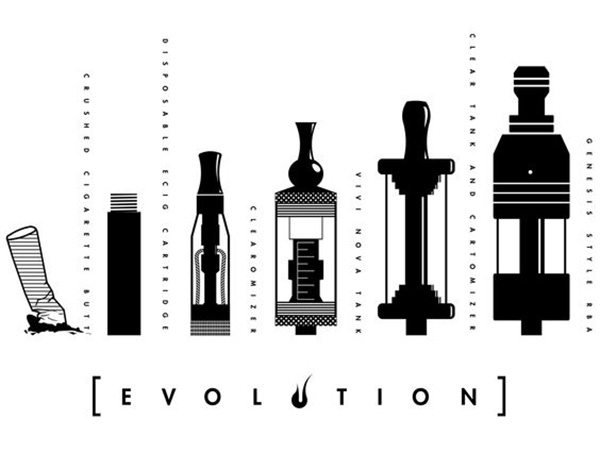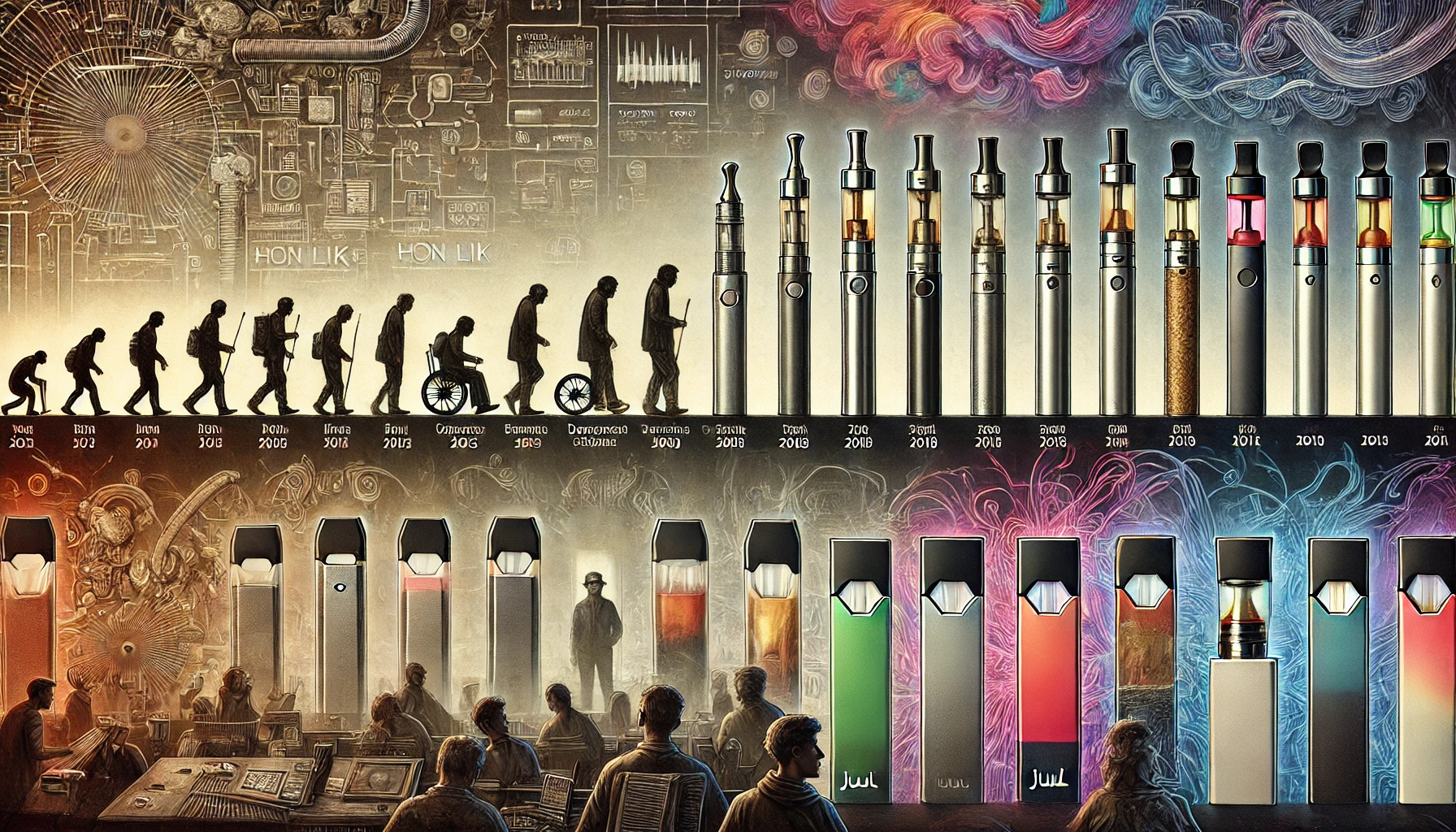Have you ever wondered about the evolution of vaping and its impact on modern smoking alternatives? This fascinating journey reveals how vaping has transformed from a niche market to a mainstream choice. As society seeks healthier options, vaping has gained significant popularity among adults seeking alternatives to traditional smoking.
The origin of e-cigarettes can be traced to the early 2000s, marking a pivotal moment in smoking alternatives. Over the years, the vaping industry has experienced remarkable growth, driven by advancements in technology and a diverse range of vape flavors.
Emphatically, the history of vaping showcases a timeline filled with rapid developments. Early vaping devices paved the way for modern vape pens, which offer enhanced user experiences. Additionally, the vaping market has expanded significantly, attracting a wide audience due to its perceived health benefits compared to traditional cigarettes.
To put it another way, the rise of vaping has not come without challenges. Regulatory hurdles have emerged as governments seek to address health concerns and ensure consumer safety. Vaping regulations history reveals a complex landscape where laws vary significantly across regions. Despite these challenges, the vaping industry continues to thrive, adapting to new regulations while maintaining its appeal.
Generally, the evolution of vaping represents a significant shift in smoking culture. Without doubt, vaping technology continues to develop; it remains essential to understand its history and the ongoing debates surrounding its health implications. By the time we look back at this journey, we will see how vaping has reshaped our approach to smoking and wellness.
The Surprising Evolution of Vaping That Every Smoker Needs to Know
The first modern e-cigarette, invented by Chinese pharmacist Hon Lik in 2003, was designed as a safer alternative to traditional smoking, utilizing a battery-powered atomizer to vaporize a nicotine-containing liquid. This innovative device marked a pivotal moment in the history of vaping. It opened the door to a new era of smoking alternatives that prioritize health and enjoyment.
Hon Lik’s creation of the e-cigarette was motivated by the need to mitigate health risks linked to traditional tobacco use. His design featured a battery-powered atomizer that vaporized a liquid solution containing nicotine, propylene glycol, and flavorings. This technological advancement established the groundwork for the contemporary vaping industry.
Also, the vaping market began to grow; it attracted a diverse audience seeking alternatives to conventional cigarettes. Advancements in vaping technology have resulted in a variety of devices, such as vape pens and sophisticated e-cigarettes. Every new device has played a role in diversifying vape flavors, enriching the user experience.
Due to the rapid growth of the vaping industry, regulatory challenges have emerged. Governments worldwide have implemented vaping regulations to address health concerns and ensure consumer safety. The history of vaping regulations reflects a complex landscape, with laws varying significantly across different regions.
In essence, the journey of vaping from its inception to its current status illustrates a significant shift in smoking culture. Nevertheless, as we delve deeper into this fascinating evolution, we uncover the intricate relationship between vaping and modern lifestyle choices.
Discover the Surprising Rise of Vaping from China to the World
E-cigarettes, which gained popularity in China before spreading globally, are associated with the act of vaping, defined as inhaling vapor produced by these devices. This phenomenon has reshaped smoking habits worldwide, leading to a significant cultural shift. The growth of vaping has generated curiosity about its development, showcasing a captivating narrative of innovation and change.
The vaping industry began its journey in China, where e-cigarettes first gained traction. This initial popularity laid the groundwork for the global spread of vaping culture. As e-cigarettes entered markets in Europe and North America, they transformed smoking habits and preferences among adults seeking alternatives.
The term “”vaping”” emerged to describe the act of inhaling vapor from e-cigarettes. This terminology reflects the unique experience that vaping offers compared to traditional smoking. As a result, the vaping market has expanded rapidly, attracting diverse consumers interested in exploring various flavors and devices.
In the light of the vaping market growth history, the evolution of vaping technology has played a crucial role. Early vaping devices paved the way for modern innovations, enhancing user experiences significantly. The development of vape pens and advanced e-cigarettes illustrates the industry’s commitment to improving safety and enjoyment for consumers.
Furthermore, the history of vape flavors has evolved alongside the technology; the history of vape flavors has evolved alongside the technology. Consumers now enjoy a wide array of options, from fruity to dessert-inspired flavors. This variety has contributed to the appeal of vaping, making it a popular choice among those looking to transition from traditional smoking.
Nonetheless, the rapid growth of the vaping industry has raised health concerns. Reports of vaping-related lung injuries have prompted calls for better regulation and safety standards. Understanding the vaping regulations history is essential for consumers navigating this complex landscape.

Evolution of Vaping Unleashes a Flavor Revolution That Changed Lives
During the 2010s, the vaping industry saw remarkable expansion, fueled by a variety of devices and e-liquid flavors, as numerous users sought vaping as a smoking cessation method. This era represented a crucial turning point in smoking alternatives, characterized by innovations that improved user experiences. The advent of nicotine salt formulations offered a gentler throat hit, drawing in a larger audience to vaping.
In addition, vaping gained popularity; many users sought it as a method to quit smoking. The rise of nicotine salt formulations became a game-changer, providing a satisfying experience without the harshness of traditional e-liquids. Consequently, this development contributed to the vaping industry’s growth, as more smokers transitioned to vaping.
In light of the vaping market growth history, the diversity of devices and flavors has played a key role. Consumers currently have access to a range of choices, from basic vape pens to high-tech mods. Every device presents distinct features, improving the vaping experience and appealing to a wider demographic.
Furthermore, the evolution of vape flavors showcases the industry’s inventive spirit and creativity; to illustrate, the emergence of DIY e-liquid mixing has empowered enthusiasts to craft their own custom flavors and nicotine levels, fostering a vibrant community around vaping. From fruity to dessert-inspired options, the flavor diversity keeps users engaged. This variety not only enhances enjoyment but also encourages smokers to explore vaping as a healthier alternative.
Because the vaping industry continues to grow, regulatory challenges have emerged. Governments worldwide began implementing vaping regulations to address health concerns. Understanding the vaping regulations history is essential for consumers navigating this evolving landscape. As the industry adapts, it continues to thrive, balancing innovation with safety.
Is Vaping Safer Than Smoking or Just a Dangerous Illusion
The rise of pod systems like JUUL has transformed the vaping market, prompting regulatory actions and ongoing public health debates regarding their safety compared to traditional smoking. This shift has significantly influenced consumer preferences and market dynamics. As a result, the vaping industry has seen a surge in popularity, particularly among younger adults.
The introduction of pod systems, such as JUUL, revolutionized the market by offering discreet and user-friendly devices. These innovations cater to a new generation of vapers who prioritize convenience and portability. In the meantime, the vaping market growth history reflects a shift towards these compact devices; which appeal to both new and experienced users.
Regulatory responses to vaping began to increase, with some countries implementing age restrictions and flavor bans to address health concerns. Governments recognized the need to protect public health while balancing the interests of the vaping industry. Given that these developments, the vaping regulations history has become increasingly complex, with varying laws across different regions.
Public health organizations have debated the safety of vaping compared to traditional smoking, with ongoing research into long-term effects. Many studies aim to understand the implications of vaping on health, particularly regarding nicotine addiction and respiratory issues. As the vaping industry continues to evolve, the introduction of new technologies and flavors will likely influence consumer choices. The history of vape flavors has expanded significantly, offering a diverse range of options that attract users. The progression of vaping illustrates not only shifting consumer tastes but also the industry’s ability to adapt within a competitive landscape.

Discover How the Evolution of Vaping Captivates Young Audiences Everywhere
How has social media influenced the rise of vaping culture among younger generations? The impact of platforms like Instagram and TikTok cannot be overstated. These sites have become essential for influencers to promote vaping, often glamorizing its lifestyle.
The rise of social media has significantly shaped vaping culture, particularly among teens and young adults. Influencers showcase their vaping experiences, creating an appealing aesthetic that attracts followers. This trend has led to a surge in vaping popularity, as young people are drawn to the community aspects and lifestyle associated with it.
Vaping has also become intertwined with various subcultures, such as cloud chasing and trick competitions. These activities emphasize the performance aspect of vapor production, showcasing technical skills and creativity. Enthusiasts often share their achievements online, fostering a sense of belonging within the vaping community.
Moreover, the emergence of DIY e-liquid mixing has empowered enthusiasts to craft their own custom flavors and nicotine levels, fostering a vibrant community around vaping. This trend has sparked a vibrant subculture focused on flavor experimentation and sharing. Enthusiasts often exchange recipes and tips, enhancing their vaping experiences and building connections.
Nonetheless, the rapid growth of the vaping industry has raised health concerns. Reports of vaping-related lung injuries have prompted calls for better regulation and safety standards. As the vaping market continues to expand; therefore, prioritizing responsible practices and consumer safety has become essential.
In conclusion, the evolution of vaping reflects a complex interplay between technology, culture, and health. The influence of social media and the rise of DIY practices have transformed vaping into a multifaceted phenomenon. Understanding these dynamics is crucial for navigating the future of vaping and its impact on society.
Is the vaping industry facing a dramatic future shift
Did you know that the future of vaping is influenced by changing laws and public attitudes? This dynamic environment shapes how consumers and manufacturers interact with vaping products.
Governments worldwide are currently navigating the complexities of vaping regulations. They aim to protect public health while respecting the rights of adult consumers. Some regions impose strict rules on the sale and marketing of vaping products. In contrast, others adopt a more lenient stance, creating a patchwork of regulations. This inconsistency complicates the landscape for both consumers and manufacturers, making it challenging to understand the rules governing vaping products.
Even though awareness of vaping’s potential health risks grows, the industry faces new challenges. Public perception is shifting, with increasing focus on addiction and health concerns, particularly among young people. This change in narrative could impact the vaping market growth history, leading to a decline in popularity. If negative health reports continue to emerge, consumers may reconsider their choices. The vaping community must address these concerns while promoting responsible practices and consumer education.
The interplay of social media influence and community engagement also plays a crucial role in shaping vaping culture. Platforms like Instagram and TikTok have popularized vaping, particularly among younger generations. However, as health concerns rise, the vaping industry must adapt to maintain its appeal. The evolution of vaping will depend on how effectively the community navigates these challenges while advocating for informed choices.
In short, the future of vaping remains uncertain. The ongoing evolution of vaping legislation, public perception, and health concerns will significantly impact the industry. The vaping community must work together to ensure a sustainable future while addressing these pressing issues.

As We Conclude the Evolution of Vaping What Lies Ahead for Smokers
The development of vaping represents an intriguing transition from historical practices to contemporary technology. This shift underscores the profound evolution of smoking alternatives throughout the years. As society seeks healthier options, vaping has emerged as a prominent choice for many individuals.
To begin with, the history of vaping traces back to ancient methods of inhaling substances. However, the modern e-cigarette, invented in 2003, marked a pivotal moment in this timeline. Hon Lik’s invention aimed to provide a safer alternative to traditional smoking, utilizing innovative technology to vaporize nicotine liquids.
In the second place, the vaping industry experienced remarkable growth throughout the 2010s. This growth stemmed from the introduction of diverse devices and a wide array of e-liquid flavors. Many users turned to vaping as a means to quit smoking, leading to a significant shift in smoking habits and preferences.
Likewise, the rise of pod systems, such as JUUL, transformed the vaping market. These devices prompted regulatory actions and sparked public health debates regarding their safety. For this reason, the vaping regulations history continues to evolve; reflecting ongoing concerns about health and safety in the industry.
In summary, the evolution of vaping encompasses a complex interplay of technology, culture, and regulation. The vaping market growth history illustrates how social media and influencer marketing have shaped vaping culture, particularly among younger demographics. As we look to the future, the development of vaping technology will likely continue to adapt to changing public perceptions and health concerns.
Give our AI Podcast a listen
Unveiling the Origins of Vaping Culture
Did you know that the first modern e-cigarette was invented in 2003? This pivotal moment marked the beginning of the vaping industry history. Emphatically, Hon Lik, a Chinese pharmacist, created this device to provide a safer alternative to smoking. The e-cigarette utilized a battery-powered atomizer to vaporize nicotine liquid. To put it another way, this invention opened the door to a new era of smoking alternatives. Additionally, the vaping market growth history reflects rapid advancements in technology and flavor diversity. Early vaping devices paved the way for modern vape pens and e-liquids. In truth, the evolution of vape flavors has captivated users, offering options such as fruity and dessert-inspired choices. Overall, the vaping timeline showcases a significant shift in smoking culture and consumer preferences. By the time we look back, we will see how vaping transformed smoking habits forever.
FAQs
What is the origin of e-cigarettes and when did they first appear?
The origin of e-cigarettes traces back to 2003, when Hon Lik invented the first modern e-cigarette. This invention marked a pivotal moment in vape history.
How has the vaping industry evolved over the years?
The vaping industry has experienced remarkable growth, especially during the 2010s, due to diverse devices and flavors. This growth reflects the vaping market growth history.
Can you explain the significance of the first e-cigarette?
The first e-cigarette, invented by Hon Lik, aimed to provide a safer alternative to traditional smoking. This invention changed the vaping timeline significantly.
What advancements have occurred in vaping technology?
Advancements include the development of vape pens and pod systems, which enhance user experience and convenience. These innovations illustrate the development of vaping technology.
How do vaping regulations vary across different regions?
Vaping regulations history shows significant variation, with some regions imposing strict rules while others adopt a more lenient approach. This inconsistency complicates the landscape for consumers.
What role do flavors play in the appeal of vaping?
The history of vape flavors has evolved, offering a wide array of options that attract users. This variety enhances enjoyment and encourages smokers to explore vaping.
How has social media influenced vaping culture?
Social media platforms like Instagram and TikTok glamorize vaping, especially among younger audiences. This influence significantly shapes vaping culture and community engagement.
What health concerns have emerged with the rise of vaping?
Health concerns include reports of vaping-related lung injuries, prompting calls for better regulation and safety standards. These issues highlight the importance of vaping health studies history.
What is the future outlook for the vaping industry?
The future of vaping remains uncertain due to changing laws and public attitudes. This dynamic environment shapes how consumers interact with vaping products.
How does the evolution of vaping reflect societal changes?
The evolution of vaping illustrates a significant shift in smoking culture, as society seeks healthier alternatives. This transition underscores the profound changes in smoking habits.
Come Visit Us
We have three fantastic locations we’d love to invite you to! If you’re in the Chicagoland area, you can come chill with us at either our Grayslake or Schaumburg locations. Alternatively, if you’re in Wisconsin, stop by and visit us at our Kenosha lounge. Please note that you must be 21+ to enter with a valid ID. We hope to see you soon!


